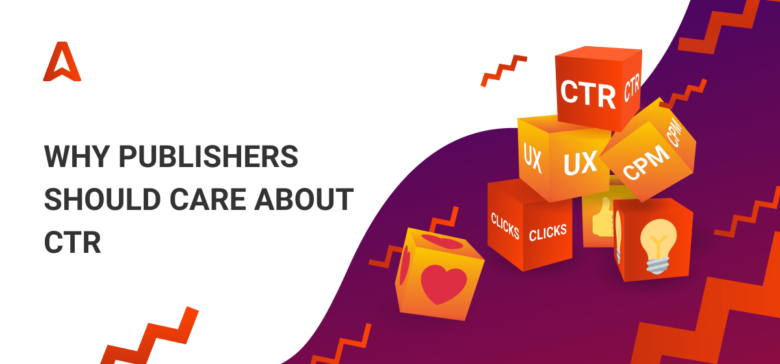When it comes to monetizing a website, one of the most common questions publishers ask is how to increase CTR. The importance of a good CTR cannot be overlooked. Whether you have some experience running display ads or you’re just starting to explore this monetization route, click-through rates are vital for your revenue. Even if your site receives tons of visitors, traffic is nothing without a decent CTR to realize the potential of that traffic.
Many webmasters and publishers indeed want to optimize their ads and increase their income, but very few do it right. Since you’re reading this, you are likely one of such publishers wondering why your website’s CTR is low and looking for ways to improve it.
We have compiled some of the best and most productive practices used, approved, and recommended by our team of experts over time. Shall we?
Contents
So, what is CTR (click-through rate)?
Importance of ad CTR and how it affects publishers’ income
8 tips to optimize ads, increase CTR and make more money
– 1 Create great web content
– 2 Regulate your ad density
– 3 Use native ads
– 4 Optimize your website structure for ads
– 5 Use related SEO keywords and effective meta descriptions
– 6 Test multiple ad setups
– 7 Pay more attention to mobile users
– 8 Integrate ad units that appeal to YOUR visitors
Other points to keep in mind when optimizing your CTR:
FAQs about click-through rate
– What is a good CTR for ads?
– How is CTR calculated?
– What is the difference between impressions and click-through rate?
Conclusion
So, what is CTR (click-through rate)?
CTR is the number of times an internet user is convinced to click your ads when they see them. To get the exact figure, you simply divide the number of clicks your ad generates by the number of times it is seen or shown. All clicks made are divided by all ad impressions.
Essentially, do ads you show make your visitors want to see what products or services are behind them? Well, most times, it’s not all the sticky captions or images. The ad type you have chosen, as well as how you have structured your web pages and filled them with content also matter a lot.
Now, if you’ve been wondering what is a good CTR for display ads in general, bear in mind that it depends on your niche. The banner ad CTR average, in general, is 0.57%. So if you can go beyond 1%, you’re in for some serious dollars! With Adsterra you definitely can, but wait for our tips that are coming a bit later.
Aside from banner ads, there are other ad formats with varying rates. Popunder ads CTR, for instance, are often higher compared to banner ads CTR. Social Bar format has demonstrated the highest click-through rates in 2020 which makes it one of the top ad types for publishers.
Importance of ad CTR and how it affects publishers’ income
For those pitting CTR vs CPM, just know that the two are not exactly comparable. CTR measures the number of clicks you get while CPM is a pricing model that pays you per impression (as opposed to clicks).
The higher the CTR on your website, the more advertisers are willing to pay for their ads’ impressions on your inventory. This is why publishers need to increase CTR. Along with other factors, it affects your CPM rates.
Clickth-rough rates help webmasters make accurate decisions on which ad type fits their audience best and — talking about banners — where it is better to place this or that ad unit. Moreover, advertising networks like AdSense and Adsterra can use the information derived through CTR to determine a particular ad’s relevance to maintain its standards.
8 tips to optimize your web pages, increase CTR and make more money
#1 Make your web content match your audience’s needs
This is perhaps the most foundational factor to double-check. Make sure your content is highly engaging and concise, which will keep your visitors coming back. Your posts may not be scientific research or benchmarks, or even ultimate guides. But if they give users what they want, you will ride high. And so the ads you place on the web pages.
The more engaging your content is, the more visits you get from the same set of visitors and the greater the potential of getting new ones. Your web traffic automatically translates into impressions, which increases your chances of getting some ad clicks.
99% of your visitors will not return if their first experience is poor. Always keep your content relevant and appealing. That’s also the point of trust. The more your users are used to getting quality content, the more they are likely to click on ads you are promoting.
#2 Regulate your ad density and find ad combinations
The number of ad units you put up on a webpage will impact your CTR directly. However, you should be careful not to overdo it. Making your web page look like a newspaper Classifieds section won’t return you neither clicks nor user loyalty.
You can regulate your ad density by choosing one-two top spots for placing banners. Web tools like Hotjar and Smartlook can give you loads of insights on what spots are the most viewable. You can play smarter and mix classic ads with the native ones (see next tips). You may find it resultative by combining banners with less intrusive ads such as in-page push. Also, you may discover secret powers of Direct Link which is an URL that can be attached to any piece of text like a typical link.
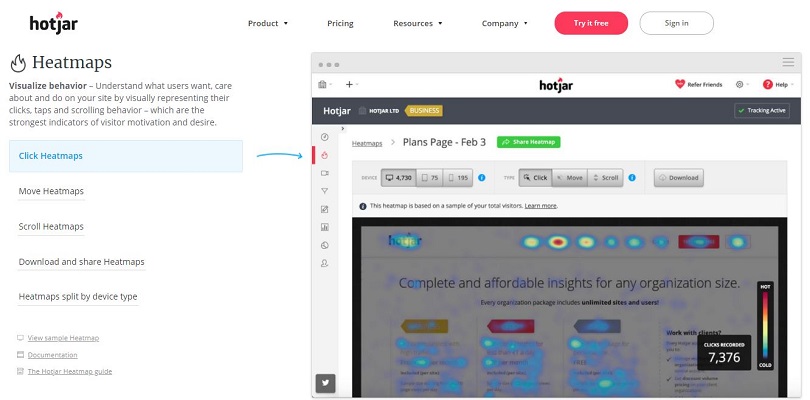
#3 Use native ads. Publishers do increase CTR with them!
The thing with native ads is that they fit the webpage like a glove. Readers consume them like a part of the original content. They do not draw unnecessary attention or seek to distract your visitors. They grab attention just like the web content users are interested in.
Native banners often come in blocks that you can modify so that they looked neat and written into the website structure and design. At least with Adsterra, you can adjust your native ads.
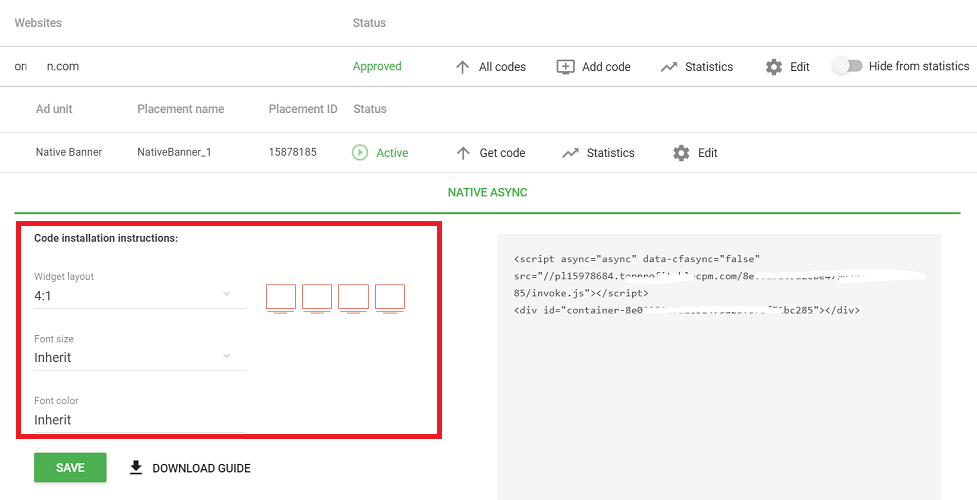
#4 Optimize your website structure for ads
Some of the favorable hotspots for display ads include sidebars, headers, footers, and in the middle of the content (especially long-form posts). You also need to consider the structural dimensions of your website or blog.
Balance the ads so that they do not affect the look of your webpage, which improves user experience and can generate more clicks.
But to guarantee publishers an increase in CTR and revenue, it is advisable to push ads to the center of the page. Statistics reveal that users find it easier to ignore ads positioned at the sidebars than those placed at the page’s uppermost center. Other eye-tracking studies support the top-left corner of the page.
Placing ads close to the navigation bar — but not overlapping it — can also help. The main idea is to balance the user’s comfort with your monetization effort. No aggressive ad experience allowed.
#5 Use related SEO keywords and effective meta descriptions
Search engine remains one of the most productive platforms for generating clicks and sales. All thanks to users always scouting platforms like Google for information on the products they need.
Ad clickth-rough rates always benefit from web content rich with such specific keywords. If you are looking for a specific audience, you prepare specific content and fill it with specific keywords that match your visitors’ search phrases.
Aside from keyword use throughout the content, meta descriptions also play a key role in increasing traffic to your site—thereby, getting more impressions and clicks. These texts should not be a rushed summary but an effective sneak peek into what your webpage holds. Ensure that those 160 characters are used effectively and creatively to invite users to your site.
Using the right keywords in the meta description also helps your site rank higher on SERPs (search engine result pages), but be careful not to over-optimize.
#6 Test multiple ad setups
Not sure if to use native or banner ads? You can use both!
Visitors have varying web behaviors and preferences. A smart publisher should be prepared for this diversity and their various reactions to various types of ads. While some users can be convinced by native ads with effective CTA, others may respond to banner ads.
Similarly, you can create a setup for new visitors and another for returning users. The mix of two or more strategies makes the ads interesting and convincing which raise the chances for publishers to increase CTR.
Also, it helps to vary your setups from time to time. Pay attention to the metrics and carefully analyze user behavior. Those Google Analytics reports with average time spent on page or average session duration are very handy.
Using the same combination of ad setups and positions for a long time is bound to result in a low CTR because returning users will soon get used to the strategy, causing a dip in productivity.
If you need to boost the performance, change the combination by adding new formats. Adsterra offers all sorts of ad formats.
#7 Pay more attention to mobile users
According to StatCounter, over 50% of all web traffic is generated from mobile devices. When people need to make quick bookings or inquiries about a product of interest, they prefer to do it on their mobile devices.
This consistent trend implies that as a publisher, your website and individual webpages should be designed to give mobile users a smooth experience.
The user interface should be responsive and suitable for all sorts of internet users to navigate without any hurdles.
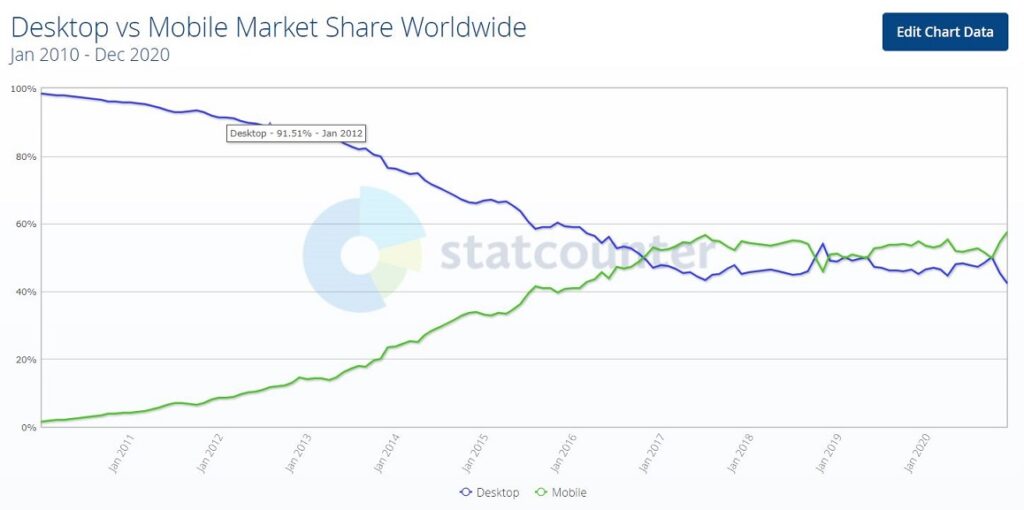
#8 Integrate ad units that appeal to YOUR visitors
Quality ads make valid impressions and guarantee responses from viewers. And what adds to this quality is a relevant ad format.
The form of your ad could vary based on the method you choose to adopt, the nature of the product or service, and the position of the ad. But always make sure it is suitable for the website niche and design. Will video ads be suitable for your website category? How will your visitors react to banners? Will native ads be noticeable?
If you invest in attracting millennials and Gen zers make sure that what they see is non-intrusive. Native banners are a win-win strategy as you get clicks and the users don’t get distracted with obvious advertisements. Social Bar ad formats like icon notifications or chat bubbles have absorbed all those fins and fads of social networks and messaging apps that could appeal to the tech-savvy users.
Checklist: what to keep in mind when optimizing your CTR
- Remove unpopular and irrelevant ad formats
- Only use keywords related to your website
- Every webpage should be mobile-friendly
- Use A/B testing to collect data on new and returning users
- Do not over-optimize
- Refrain from using leaderboards that ruin your web design
- Do not buy false clicks as the advertisers will soon reveal it and blacklist your website
FAQs about click-through rate
What is a good CTR for ads?
Since the average CTR on the Google Display Network is around 0.57%, a rate of 0.8-1% is good enough to generate some decent income. This affects how much money your website makes from advertising.
How is CTR calculated?
Divide the number of ad clicks by the number of ad impressions.
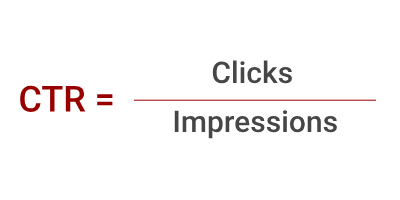
What is the difference between impressions and click-through rate?
While impressions refer to the number of times an ad is displayed, CTR is the ratio of clicks generated to the impressions. Publishers need to increase CTR as it marks the quality of their websites’ traffic.
Conclusion
We hope this piece has given you some insights, tips, and rules to help improve your click-through rates. But the weightiest element of a CTR increase for publishers is audience research and engagement.
At Adsterra, we’re interested in helping you achieve the best click-through rates possible. We provide viable solutions that convert your impressions into income with 100% fill rates and the best CPMs.
For one, we’ve developed some exclusive ad formats that have revolutionized the ad market. A perfect example is the Social Bar ad format, which increases ad CTR by up to 30x compared to classic web push, for instance.
Sign up here to place your first ads and start earning today!
